Woodley the early years to 1900
Archaeology gives us the first signs of human occupation in Woodley.
The Historic Environment Record for Woodley contains over 50 records of artefacts such as flint tools and metal finds dating from 500,000 years before present to Roman times.
The gravel and sand banks of the area were important as a resource for stone implements and as sites of occupation in a marshy environment.
Some artefacts were found in the many gravel extraction plants in the area. Mr Chandler of the Ham River Grit Company found two Stone Age hand axes in the workings at Butts Hill Road (Berks Arch Journal no 59). Another was found on the conveyor belt at Woodley Aerodrome gravel pit and reported in BAJ 66). Neolithic stone knives were found in the gardens of 71 Coleman’s Moor Road and 37 Lund’s Farm Road.
An excavation at Duffield House in the 1990s found evidence of a Bronze Age settlement. Roman coins were found in various places in Woodley. There were no major sites such as Roman villas.
The name Woodley means “a clearing in the woods”. It is sometimes said that it was part of Windsor Great Forest. However, maps of 1607 and 1823 of Windsor Forest show that it ended at the River Loddon.
It was a collection of hamlets in the forest: Woodley Green, Norris Green and Wheelers Green. Some of the land was not forest but heath or marsh. Bulmershe was where bulls were pastured for the bull baiting in Wokingham.
Woodley was not mentioned in The Domesday Book. The manors of Sonning and Earley were listed. The Domesday book said “Osmund Bishop of Sonning holds Sonning in lordship”. Woodley was part of the parish of Sonning until 1881. It also mentioned a manor at Earley and two mills on the river Loddon, one of which may have been Sandford mill.
The first reference to Woodley was found in the archives of Salisbury cathedral. “Osbertus de Woodleghe holds a dwelling house and yard and is able to pastures his pigs on the Lord of the Manor’s woods.” This is from the Registers of St Osmund, recording a visit to Sonning in 1220. Woodley is also spelled Wodlegh or Wodleyhe in early documents. Woodley Green was a name found in 1603-4 in Rentals and Surveys held at the National Archives.
Thomas Pride’s 1790 map of Ten Miles Around Reading shows Woodley as a hamlet called Woodley Green. It also shows Bulmershe Heath, Coleman’s Moor, Sandford Mill and scattered farms and cottages. The road to the north with a turnpike near Sonning is the London and Bath Turnpike Road, now the A4. The road to the south had a turnpike to the east of the River Loddon and was known as The Windsor Forest Turnpike Road or Forest Road in the 18th century.
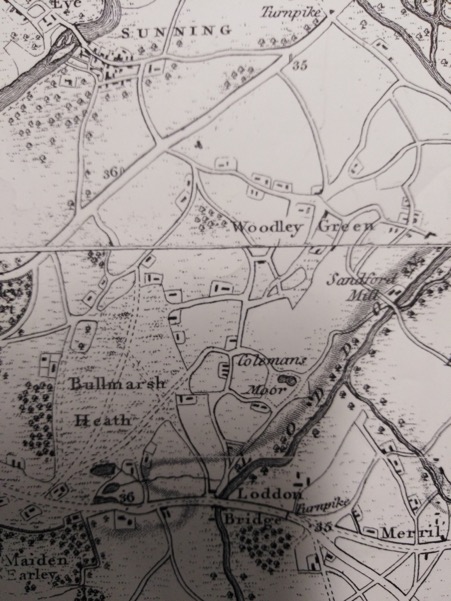
Bulmershe was first recorded in a land exchange between Bishop Jocelin and John of Earley in the late 12thcentury. They exchanged 2 virgates of land at Bulmershe. A virgate was ¼ of a hide (the land needed to support a household for a year) or 30 acres. In 1447 the manor of Belvershal called Bulnassh was granted by John Lovell to Richard Earl of Salisbury. The manor was owned by Reading Abbey at the time of the dissolution in 1536.
Bulmershe Manor was bought by William Gray (sometimes spelled Grey) MP for Reading, after the dissolution. His name was remembered in William Gray Junior School in Fairwater Drive which closed in 1999. William Gray had no children, so Bulmershe Manor was inherited by his wife’s son John Blagrave, from her first marriage to Robert Blagrave.
John Blagrave married Anne Hungerford of Little Shefford and had 4 sons. Her name survived in the name Hungerford Lodge and the area Little Hungerford. One of his sons, John was the mathematician who wrote The Mathematical Jewel and a book on The Making and Use of a Staff. He left a prize of 20 nobles to be competed for by 3 maidservants from different parishes in front of the mayor and aldermen on Good Friday. In the Civil War, Anthony Blagrove of Bulmershe Manor was a Royalist. His son Daniel, of Southcote Manor, was MP for Reading in the 17th century and signed the death warrant of Charles I. The Blagrave family also owned Southcote Manor.
Records from the 1662 hearth tax show that Woodley had 73 people who owned a property with a hearth. The biggest tax payer was George Blagrave of Bulmershe who owned 12 hearths, then Thomas Soual of Sandford and John Round of Colemans Moor who both paid tax on two hearths.
Henry Addington
In 1789 the executors of the last member of the Blagrave family sold Bulmershe Manor to Henry Addington. He was the son of a Reading doctor, Anthony Addington, who moved to London and had George III and the two prime ministers William Pitt the elder and younger among his patients. Henry Addington was a school friend of William Pitt the younger and succeeded him as prime minister.
Henry Addington was the only Woodley resident of national importance. He was speaker of the House of Commons and later prime minister 1801-1804. Sadly he was not regarded as a great prime minister and is not well known today. He negotiated the Peace of Amiens in 1802 with Napoleon, because he felt the continuing war was unaffordable. Income tax had been introduced to pay for it! He tried to put the British government on a better financial basis. He gave what is regarded as the first budget speech in Parliament.
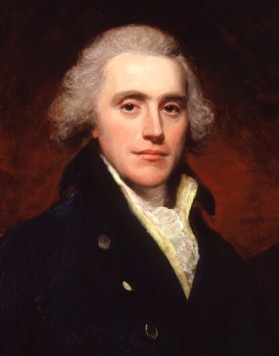
He became Viscount Sidmouth in 1805. He and his wife gave land on which the Royal Berkshire Hospital was built. He lived in a newly built house called Woodley Lodge every summer from 1789-1801.The house was lit up by candles when there was good news from the Napoleonic war. He was the Captain Commandant of Woodley Yeomanry, a volunteer cavalry regiment formed by gentlemen and wealthy farmers who owned horses. The Captain was Edward Golding Esq. and the Lieutenant was Richard Palmer Esq. One of the Corporals was John Pottinger. Addington, Palmer and Golding were the major landowners in Woodley at the time. The Yeomanry were intended to fight in case of an invasion by Napoleon’s army. Privates included John Blagrave, James Wheble and John, Henry and Charles Simonds of the Reading brewing family. The Yeomanry were reviewed by George III in 1799 on Bulmershe Heath. The Chequers pub was used for refreshments.
Henry Addington’s name is remembered in the Addington School in Woodlands Avenue and Addington Gardens off Loddon Bridge Road. Two streets in Reading: Addington Road and Sidmouth Street are named after him.
Reading Races
The annual Reading Races ran from 1727 until 1814 on Bulmershe Heath. The races were usually held in the last week of August. They became so popular that they grew from a meeting of three races a week in the 1740s to three each day in the 1770s.
Horses were entered for the races at The Mitre tavern in Reading. Owners had to live in Berkshire, Oxfordshire, Hampshire or Wiltshire.
Races were advertised in the Reading Mercury newspaper. In 1746 the newspaper announced:
“Tuesday 5th August any mare or gelding
Wednesday 6th hunters carrying 12 stone
Thursday 7th any horse that has never won fifty pounds at any one time, matches excepted carrying eleven stone.
“A Subscriber to pay one guinea and a half entrance, or three guineas at the post. A non-subscriber three guineas or five at the post…
“The owner of every winning horse to subscribe two guineas to the plate for next year. A subscription Cock match will be fought every morning during the races at Sacheverall Barnham’s cockpit, at the Golden Bear Inn and there will be assemblies at the Town Hall every evening”.
The Reading Races were part of a week of entertainment and people came from as far away as London.
The Reading Mercury for 11 August 1746 reported the results and a fatal accident:
“On Tuesday last at our races on Bullmarsh Heath, Lord Leigh’s chestnut horse Sauce Boy won the plate and Mr Martindale’s chestnut horse Hercules the stakes.
On Wednesday Mr Jenning’s sorrel gelding Conqueror won the plate and Mr Allen’s bay mare Sweetest When Naked the stakes. And on Thursday Mr Parson’s Brabraham won the plate and Mr Grifword Crop(sic) the stakes.
At the said races on Wednesday Mr Barnaby Lever a grocer of David Street near Grosvenor Square was unfortunately pushed off his horse by the pole of a chariot by which he received such bruises that he died on the spot”.
On 25 May 1747 the Reading Mercury reported “No person will be permitted to sell liquors on Bullmarsh Heath during the races without they subscribe five shillings at least towards the plate which must be paid to the clerk of the course before they begin”. This gave The Chequers pub an effective monopoly on selling alcoholic drinks to racegoers.
The 1820 enclosure of Woodley ended racing on the heath and it moved to Kings Meadow in Reading. Cudgel fighting was also a popular sport. It took place several times a year on Bulmershe Heath. The main event was on Whitsunday.
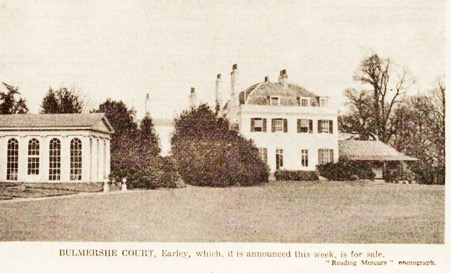
Bulmershe Court was built by James Wheble in 1777 on land inherited from an uncle and sold to Addington in 1789. Addington extended and improved it while he lived there. Bulmershe Manor, the Elizabethan house, was let to tenants. In 1801 Addington sold both houses to James Wheble, the son of the previous owner. He was a Catholic and built a chapel at Bulmershe Court. He renamed the house Woodley Lodge. He also bought much of the former Reading Abbey lands in order to research its history. He gave some of this land and money to build St James’ Catholic church in Reading.
There was a manor in Woodley called Haywards Manor. It was first mentioned in a document of 1502 and owned by the Vyel or Viall family. A lease of 1609 mentions farms called Vyals and Colemansmoor.
The 1820 Enclosure
In 1820 Woodley was enclosed. Over the centuries, rich men had acquired plots of land all over Woodley and Sandford. The enclosure gave them a chance to consolidate their holdings, though there were legal disputes. Three big landowners divided the land: Mr Robert Palmer of Holme Park in Sonning held the northern and eastern land (more than 1805 acres), Mr James Wheble of Bulmershe Court, or Woodley Lodge, the land to the west (more than 745 acres) and Mr Edward Golding the land to the south, including parts of Earley (more than 410 acres).
There were 41 landowners in 1820, including the big names of Palmer, Wheble and Golding.8 of them were female: Lucy Cook, Mary Cox, Widow Davis, Dame Mary Eyre, Dinah Gosling, Mrs Elizabeth Kent, Ann Taylor and Widow Wiggins. Some owned allotments or a cottage with enough land to grow vegetables, keep a pig or a few chickens. Most had under one acre.
Poor people lost their rights to cut furze for fuel, take rabbits and other game and pasture their animals. In compensation, they were given the Poor Lands allotments in Headley Road near the Workhouse.
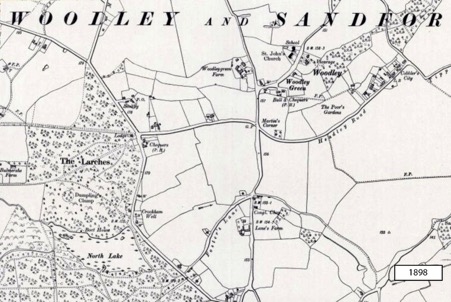
Woodley in the mid 19th Century
In 1847 Kelly’s directory described Woodley as “a scattered village and consists principally of farm houses. James Wheble has a neat residence here called Bulmershe Court. There is a market for fat cattle, held at Loddon bridge every Monday, which is well attended by butchers from Reading and the vicinity”. It listed the main farmers and tradesmen:
Samuel Aldridge – The Bull and Chequers
John Evans – blacksmith
Thomas George – The Chequers, Bulmershe Heath
William George – The Land’s End
William and George Goddard – farmers Loddon Bridge Far
Edwin Gosling – farmer Sandford Farm
David Ilton – farmer Woodley Green Farm
John Lunn – farmer Woodley Green Farm
John Manners – farmer, Coleman’s Moor Farm
Mrs Jane May – miller, Sandford Mill
Alex New – The Lamb, Wheeler’s Green
Mrs Maria Pither – farmer Earley,
Richard Smallbone – farmer
William Waight – farmer and sheep salesman, Loddon
William Watts – The Red Lion
William Wheelwright – The George Inn, Loddon Bridge
The Lamb and The Red Lion were short-lived inns set up after the 1830 Beer Act, which allowed people to sell alcohol from their homes.
The other inns had been in existence since the 18th century and possibly earlier.
The Shepherd’s House was listed under Earley in the 1847 Directory and the landlord was William Gregory. The original pub was at the bottom of Shepherd’s Hill, at the junction of London Road and Shepherds House Lane. In 1869 the landlord was Stephen Adams and in 1876 Jabez Hankin. Confusingly, the Earley part of the 1847 Directory lists Richard and William Manners as farmers in Woodley, but not John Manners. There is also an entry for James Wainlow who was a farmer in Woodley. The boundaries of Earley and Woodley were not fixed at this time.
The 1851 Census of Woodley and Sandford gave the population as 449 people. Over half were under twenty one. 93 were agricultural labourers. Most lived in tied cottages on the big estates. Farmers also rented from the estate owners, rather than owning their land. Robert Palmer built model cottages for some of his workers in Church Road, Mustard Lane and Norris Green. The three big estates in Woodley kept the area rural in the 19th century. In the early 20th century, they were sold and land was released for building houses.
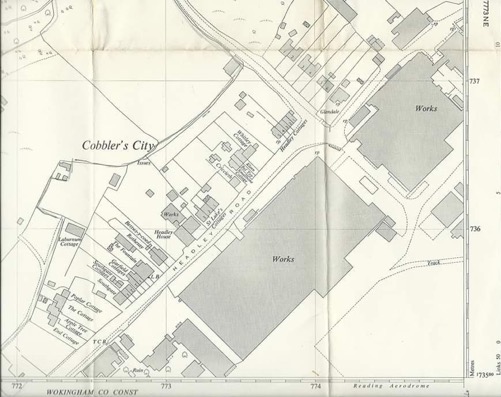
Cobblers City
Some houses were built at Cobblers City and along the main roads. Cobblers City was at the junction of Headley Road East and Tippings Lane. It was an area which was not controlled by the estate landlords. A few of the old cottages remain and are listed buildings. Many people worked on the land or in rural crafts like furniture making. Census records show that no-one in Cobblers City made or mended shoes. It is thought that the name came from the expression to cobble together, that is to make do with cheap housing and multiple, insecure jobs.
Cobblers City in the late 19th century had a shop, a Post Office, the Zilvo bakery, workshops, and the original site of St Luke’s Home for Sick Children which later became the Woodley Working Men’s Club. For more information about shops in Woodley and St Luke’s Home, see separate articles. The nearby workhouse was built in 1790. It was converted into rented cottages when Wokingham Union built a new workhouse for the whole area in 1848.
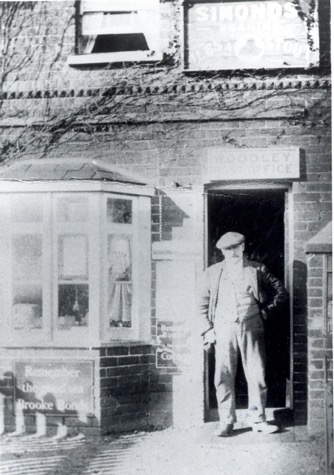
The Bulmershe estate was a self-contained world in the 19th century. It had its own pumping station, water tower, gas holder and blacksmith, in addition to Woodley Farm, (called Bulmershe Farm by the 1930s) and Lane’s Farm.
It was only when the big estates were sold that land became available to build houses. The Holme Park estate was sold in 1910-11. It included Lund’s Farm and Coleman’s Moor Farm. Outlying parts of the Bulmershe estate were sold in 1908.
Captain James St. Lurence Wheble sold Bulmershe Court to Joseph Rushbrooke in 1912 and moved to Hungerford Lodge -previously called Earley Cottage- near Earley Station. The big house, estate and the farms were sold by auctionby the executors of Joseph Rushbrooke in 1926. Three years later there was another sale.
Bulmershe Court was sold to Mr and Mrs Bernard Short who liked drama. They converted the chapel into a theatre and many productions were held there. The Earley Players were regular performers. In 1939 the house was sold again. It had been reduced in size but still had a 100 seat theatre and “an imposing Georgian Orangery”. During World War Two, the house was used by the Ministry of Defence and American troops were stationed there. After the war it fell into disuse and many Woodley residents remember playing there as children. In 1962 the house was demolished, despite a campaign to save it and the Orangery. Bulmershe College of Education was built as a teacher training college. It merged with Reading University in 1989. The University decided to concentrate its teaching on other sites and the campus closed in 2011-12.
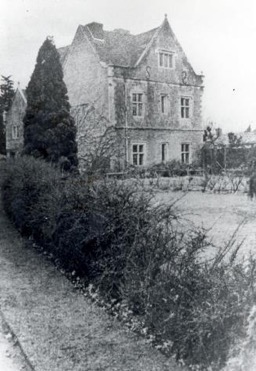
The original Elizabethan manor, Bulmershe Manor had fallen down the social scale after Bulmershe Court was built. It was divided into two cottages occupied by farm workers, though it kept the original oak staircase. It was sold as two cottages in 1926 and bought by Mr Budd who recognized its historic importance. He added oak panelling and other Elizabethan features rescued from Billingbear House, which had burned down. Sadly his wife thought the house was haunted and never wanted to live there. It was sold again in 1935 and the contents included valuable antique furniture: a Jacobean chest, a Chippendale bookcase and 6 dining chairs from the reign of George I.
The coming of the railways affected Woodley. In 1840 Brunel completed the Great Western Railway between Paddington and Reading. The excavation of Sonning Cutting employed 1220 men. A teenage boy who was injured at work was the first patient at the newly opened Royal Berkshire Hospital. He had to have an arm amputated but survived the operation. In the records, his address is given as Lands End. It seems likely that most of the workmen lived in temporary accommodation near the diggings. In April 1839 George Greenaway was killed in a fight outside the Bull and Chequers pub by a fellow worker John Siddall. He was egged on by 30 railway workers. The court took a lenient view of this and Siddall was let off with a fine and a short stay in prison.
In 1845 the Reading-Reigate Atmospheric Railway was proposed to the south of Woodley. The line opened in 1849 and three years later, The South Eastern Railway took it over. Earley Station was opened in 1863.A hundred years later Woodley Parish Council proposed that the name be changed to Woodley and Earley Station, but British Rail declined the suggestion.
For more information about the railways see separate article on Transport – click HERE.
Chapel, Church and School
In 1834 the Reverend James Sherman of Reading built the Congregational Chapel in Loddon Bridge Road. It had a small school attached. This chapel and school were the first in Woodley. Before this the only schools were dame schools run by farmers’ wives at Lunds farm and at Fosters farm.
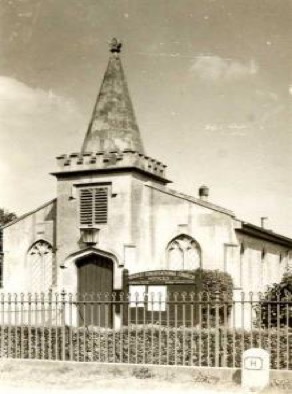
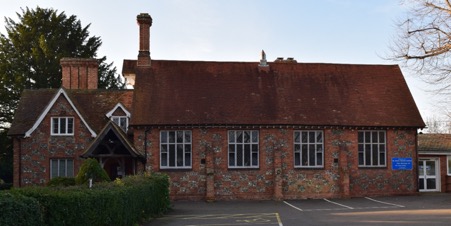
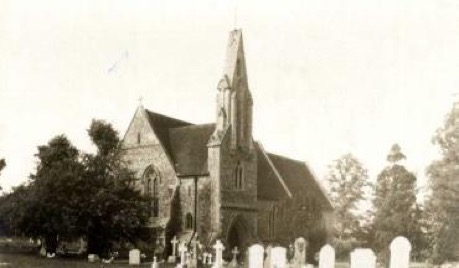
The original building consisted of the school house and the long room with the infants’ classroom at the back. Caroline provided the money for the school and its maintenance. The building was designed by the architect Henry Woodyer.
Caroline was a school manager and she wrote articles about the school for the Sonning Parish Magazine. She also read the reports of HM’s Inspectors, who were appointed to impose the standards set out in Lord Shaftesbury’s 1870 Education Act. The new school was used for evening classes, Ladies’ Club meetings and clothing sales. It housed the Woodley Village library of 400 books and in 1920 it hosted the first meeting of the Woodley WI.
In 1873 St John the Evangelist Church was built, paid for by Robert Palmer. The architect was again Henry Woodyer. The tiles in the church were laid by Mintons, the leading English tile maker.
From 1873-1881 a curate from Sonning took services in the church. The Vicarage was opposite and the first vicar was The Reverend Ernest Angel Gray. He was appointed in 1881 when Woodley and Sandford became a separate ecclesiastical parish.
Woodley had been part of the parish of Sonning for hundreds of years.
For more information about churches see the article by Shirley Slade – click HERE.
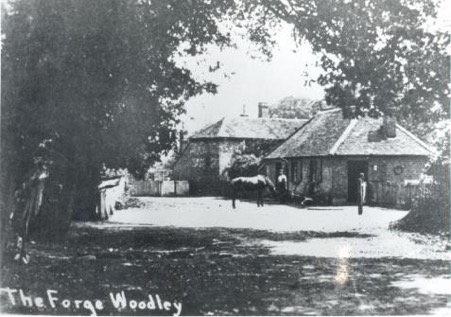
The forge in Woodley was near Headley Road, where Farriers Close is today. In 1847 John Evans was the blacksmith. The Evans family lived in Headley Cottages in Cobblers City and generations worked on the Great Western Railway.
The blacksmith John Wadhams in 1897 combined the job with running the post office and being parish clerk. His son took over as blacksmith by 1907 and was last listed in Kelly’s Directory of 1931.The 1939 register lists a blacksmith William Abbott living at Blacksmith’s Corner in Reading Road. After that there were no mentions of blacksmiths in Woodley.
Sandford Mill is on the River Loddon. The present building dates from the 18th century. There were two mills recorded in Sonning in the Domesday book 1086 and it sems likely that Sandford Mill was one of them. In the English Civil War in the 1640s the mill was sacked and the bridge destroyed. The mill burned down again in 1768, apparently arson by the miller.
For further details see separate article on Sandford Manor and Mill – click HERE.
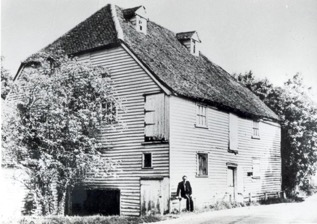
Farms in the 19th Century
Information about farms comes from the censuses of 1841-1891 and Kelly’s Directories:
Bulmershe Park Farm-also spelled Bulmarsh or Bullmarsh. This was the home farm for the Bulmershe estate. On the 1843 tithe map it was called Woodley Park Farm. Later it was known as Woodley Farm or just The Farm. John Lane was the farmer in 1861 and 1871, George Bayliss was listed as a retired farmer in 1881. In the 1881 census it was called Bullmarsh Park Farm. Charles Hayden was the farm steward, the farm was 187 acres and it employed 10 men and 3 boys . By 1897 F. Hart was the farm steward and Ernest Reeves in 1907. The 1898 OS map names it Bulmershe Farm. It was known as Bulmershe Farm in the 20th century.
Coleman’s Moor Farm was farmed by John Manners, then by his sons John and Richard in 1871, then William May in 1881. In that year it had 270 acres employing 5 men and a boy.
Foster Lane Farm, later known as Richardsons is rarely mentioned in 19th century records. On the 1843 tithe map, a small holding was shown with John Manners as the tenant farmer. It was possibly one of the four farms listed without a name or address as Dairy farm, Woodley in the 1896 electoral roll: The farmers were William Alder, Charles Bartlett, Thomas Bristow and Charles Hayden.
Lunn’s farm was shown on the 1871 Ordnance Survey map and farmed by George Bassett in 1896. In the 20thcentury, the name became Lund’s Farm.
Sandford/ Davis/Plants Farm: were 3 small farms which were usually farmed by one tenant. James Davis and Thomas Plant were farmers who gave their names to the farms. The farmer was Edwin Gosling in 1841, Thomas Righton in 1861 and 1871, Frederick Righton in 1881. In 1881 the farm was 513 acres and employed 11 men and 3 boys. Henry Phillips was the farmer in 1896.
Woodley Green Farm: David Ilton was the farmer in 1841 (also with John Lunn in 1847 according to Kelly’s directory) and 1851 according to the census, George Bayliss in 1861 and 1871. The 1887 Kellys Directory has John Hurst Baylis as the farmer.
William Pither was listed in the 1881 census as a farmer of 105 acres, employing 2 labourers and a boy. – does not give an address -was it Woodley Green?
1847 and 1869 Kelly’s Directory has Abraham, Maria and William Pither farming in Earley.
Woodley at the End of the 19th Century
In 1887 Queen Victoria celebrated her Golden Jubilee. Richard Palmer gave a field on Headley Road at low rent to be a recreation ground for the people of Woodley. It had allotments, a cricket and football ground. At the end of WW1 an old army hut was added to be a hall and meeting place for the village. It became known as the Memorial recreation Ground.
In 1891 the population of Woodley and Sandford was 1095. By the end of the 19th century, Woodley had many institutions set up by local Victorian philanthropists. Kelly’s Directory of 1897 lists:
St John’s parish church and school – Miss Britton was head of the junior school and Miss Bass the infants school- the Congregational Chapel, a Working Men’s Club, a Convalescent home for Men, matron Mrs Grant, a Convalescent Home for Women in Mustard Lane, matron Mrs Serjeant and a Convalescent Home for Boys also in Mustard Lane, matron Mrs Christmas. There did not seem to be a Convalescent Home for Girls. St Luke’s Home for Sick Children was a convalescent home for children from London who needed country air and rest to recover from TB, diphtheria and other infectious diseases.
In 1897 the Rural District Councillor was William Campin and he represented Woodley and Sandford on Wokingham Council. He was the farmer at Lane’s Farm.
The Parish Council consisted of George Aldridge who ran the shop at Cobblers City, J. St. L. Wheble, a member of the family who lived at Bulmershe Court for most of the 19th century, W.H. Norman, Thomas Wheelwright, William Hunt, Shadrack Burt of the Congregational Chapel, and the Reverend E.A. Gray vicar of St John’s.
William Wheelwright had been landlord of The George in the 1870s. Several surnames crop up again and again in the history of Woodley: The Evans family, the Aldridge, Deadman, New, Wheelwright and Pither family.
In 1897 Richard Roake was the publican at The George, William Burt ran The Bull and Chequers, Jacob Webb The Land’s End and John Williams ran The Chequers.
A typical entry in the 1897 Kelly’s Directory lists James Gilbert Smith as a grocer, beer seller, plumber and decorator. Most Woodley people worked as farmers, agricultural labourers, kept chicken farms, dairymen, shepherds, hurdle makers, market gardeners, gamekeepers and shepherds. Woodley was still a village. Most houses had a name not a number and roads were not named, because local people knew where they were. This would all change in the 20th century.
Sources
1820 Enclosure map and award – Berkshire Record Office Q/RDC 97
1843 Tithe map – Berkshire Record Office D/P113 27/1A
Census records 1841-1891
Kelly’s Street Directories 1847-1897 – Reading Borough Libraries
Woodley in the 19th Century by Frances Lloyd
The Woodley Album by Elizabeth Simmonds
Additional research by Ian Couper and Linda Martin.
